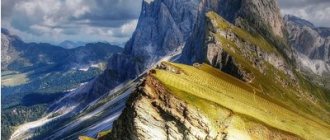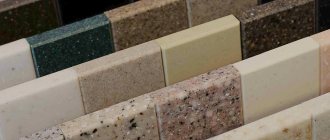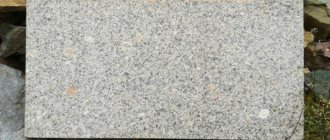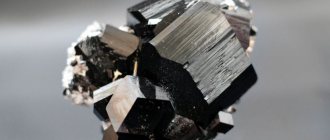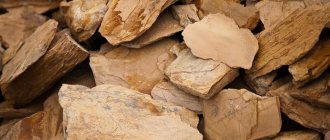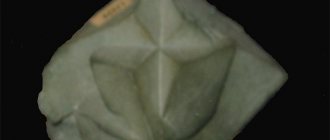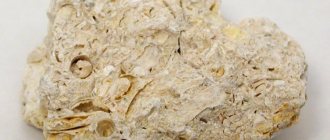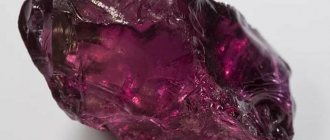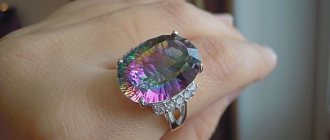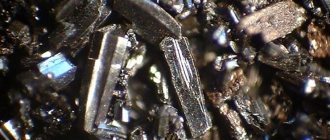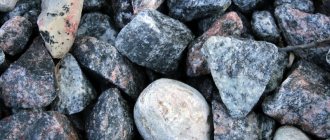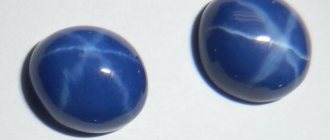What is tuff?
Tuff is a rock of volcanic, geothermal and sedimentary origin, formed during the outpouring of magmatic material onto the surface or during the deposition of carbonate and siliceous solutions in places where geothermal springs emerge.
Accordingly, carbonate (calcareous), siliceous (felsite) and volcanic tuffs are distinguished. Calcareous tuffs are intermediate forms between limestone and marble.
Volcanic matter can subsequently mix with sedimentary rocks: ash, clay particles, sand. All this material cements to form volcanic tuffs .
Volcanic and sedimentary material can be transported considerable distances from the eruption site and deposited in natural depressions. During the weathering process, new chemical compounds are formed, which precipitate and give new deposits of secondary genesis.
Distinctive features of tuff as a rock are the absence of layering and particle sorting. Almost the entire volume of the rock is occupied by pyroclastic (volcanogenic-sedimentary) material. Tuffs are often found in close proximity to volcanic rocks.
Formation of pyroclastic rocks and their characteristic features
Volcanic tuff Pyroclastic rocks Pyroclastic rocks are formed during explosive volcanic activity due to the accumulation of mainly solid products of volcanic emissions. Among the material of volcanic emissions, fragments of rocks erupted during an explosion may also be of significant importance; In addition, pyroclastic material is often mixed with normal sedimentary material syngenetic to it, deposited on the land surface (due to water flows) or at the bottom of water basins. The condition that determines the classification of rocks as pyroclastic is the synchronicity of their volcanic eruptions. Pyroclastic rocks are to a certain extent a connecting link between sedimentary and igneous rocks (effusive). Among pyroclastic rocks, the most common are volcanic tuffs, characterized by a sharp predominance of fragments of volcanic origin, in the spaces between which there is often an ash mass consisting of finely ground volcanic glass. Cement is usually formed by the products of hydrochemical decomposition of ash material, which are a siliceous-carbonate, siliceous-clayey mass. In tuffites and tuffogens, the amount of sedimentary material increases and a transition to clastic rocks is observed. On the other hand, tuffs pass through tuff lavas and so-called ignimbrites to normal effusive rocks. Tufolavs are rocks in which fragments resulting from volcanic eruptions are cemented by lava. The main feature of pyroclastic rocks is their unique structure, characterized by 1) the presence of angular fragments of rocks and minerals (ejecta from lavas); 2) heterogeneity of composition and structure; 3) lack of sorting of material; 4) a small amount of cement; 5) the usual lack of well-maintained layering. Only in some (volcanic) tuffs of marine origin can these features be expressed less clearly. For example, due to the deposition of volcanic emissions from the aquatic environment, some sorting of the material and the formation of a layered texture may occur. In general, these rocks are often characterized by irregularity in strike and dip. Pyroclastic rocks are often associated with effusive rocks. Sedimentary rocks that arose during the erosion and redeposition of pyroclastic and effusive rocks are not pyroclastic, but belong to sedimentary rocks proper. This kind of sedimentary deposits are characterized by:
1) known sorting of fragments by size;
2) less angularity (than in tuffs) or even roundness of the fragments;
3) layering;
4) psammitic or psephytic structure;
5) interlayering with normal sedimentary rocks - sandstones, etc.
A typical example of rocks that arose during the erosion and redeposition of tuffs of the main series are greywackes
Properties of tuffs
Tuffs are porous rocks that are durable and easy to process. Tuff as a rock has a very low specific gravity. The composition of tuffs may include various fragments of other rocks of different sizes, sizes and degrees of roundness.
Depending on which volcanic material is the main one in the composition of tuffs , the following types are distinguished: basaltic, trachytic, liparitic and andesitic.
Overview of species
Almost 90% of volcanic tuffs consist of products - emissions from explosive eruptions. Frequently there is movement of clastic material by mud flows and saturation of the rock with secondary minerals. If other impurities predominate, then the tuffs are divided according to their mineral composition into:
- andesitic;
- liparitic;
- basalt;
- trachytic.
Tuffs can be sintered or cemented; their strength characteristics depend on the method of formation. Sintered rocks are stronger than those cemented with natural cements.
Based on density they are divided into:
- the tracks are tightly compressed;
- pozzolans are loose.
Tuff deposits and mining
Tuffs come in different colors. Pink tuffs are mined in deposits in Armenia. The most famous deposit of mountain tuff is Artikskoe with huge reserves of pink tuff.
Pink volcanic tuff is also found in Russia, in Kabardino-Balkaria. Yellow-brown tuffs are mined in Russia, in Kamchatka. An amazing variety of tuff - golden tuffs - are found in Georgia.
Black, dark gray tuffs are mined in Armenia, near Gyumri. Some varieties of tuff have variable composition in different parts of the deposits. Red and yellow tuff is known from deposits in Iran. In total, there are about 30 tuff shades, most of which are warm shades.
In the photo you can see pure pink tuff from deposits in Armenia. The most famous deposits of calcareous tuff are located in Turkey and Armenia.
In addition, there are tuff deposits in the country of hydrothermal springs - Iceland, New Zealand, Azerbaijan and the USA in the hydrothermal Yellowstone Park, Italy, Cape Verde, Germany, Kyrgyzstan and Tajikistan.
Tuff is mined by open-pit quarrying with bench-mounted faces. Developments are carried out using classical technologies using domestic and imported special equipment. Tuffs occur both as separate layers, interlayers, and as lenses, inclusions, interspersed with other sedimentary and pyroclastic rocks.
Tuffs with a predominance of the coarse clastic fraction - large sizes, slag fragments - are deposited at a considerable distance from the eruption site, tuffs with fine clastic material accumulate in the immediate vicinity of the volcano. Tuffs are delivered to Russia from Turkey, which is the main importer of natural tuffs. Our country also exports stone from India, China, Brazil, and Armenia.
What does it look like
Volcanic tuff is characterized by a clastic-porous structure, low density, heterogeneous composition, and variable color. It can be in the form of dense volcanic tuffs (traces) and loose volcanic ash (pozzolans). This material can be pink, red, purple, yellow, orange, brown, gray and black.
Applications of tuff
Tuffs are used in construction. Many buildings in Armenia, Russia, France, Italy, and Azerbaijan are built from tuff. The widespread use of this rock is due to its lightness and strength. Tuffs are easy to process and polish; no sophisticated technological tools are required.
Volcanic and calcareous tuffs are used for facing work, and siliceous tuffs are used only for interior decoration. Armenian volcanic tuffs are used for lining stoves, pipes and chimneys, temperatures in which do not exceed 8000 C.
Specially prepared crushed tuffs are used as aggregates in lightweight concrete. Such aggregates are made from waste from the production of facing slabs and can be produced directly at the tuff deposit.
Such tuff additives in cement contribute to the resistance of constructed objects to seawater activity. In addition to these applications, crushed tuff is added to paint and varnish products.
Construction tuffs provide good heat and sound insulation of buildings. They are also characterized by high water resistance and frost resistance. Tuffs are used in construction in harsh climatic conditions, in the mountains.
Despite their light weight and ease of installation, tuffs are durable and wear-resistant. These properties ensure the universal use of tuffs for construction. Buildings decorated with multi-colored tuffs look interesting: yellow, pink, purple, brown, red, orange, black.
A wide range of colors allows the use of tuffs with both natural and artificial finishing materials for building facades to give an individual, unique appearance.
In interior work, decorators use tuffs to decorate fireplaces, cellars and even walls, for external masonry and for landscape design. Tables and chairs, decorative columns, balusters, railings, gazebos, steps and baseboards, cabinets and walls will enhance the effect of naturalness and naturalness of natural stone. In offices and massage rooms, tuff is used to decorate walls: it maintains an optimal microclimate in the room and isolates the room from extraneous sounds.
Landscape designers use tuff to build swimming pools and aquariums. Tuff is able to accumulate solar heat, and therefore serves as an ideal material for lining the bottom and walls of pools. Houses made of tuff look very advantageous, no matter what style of future cottage or country estate is chosen. A house made of tuff is almost eternal.
Armenian churches high in the mountains are exposed to huge temperature changes throughout the year and have stood unchanged for 7-8 centuries. The Colosseum in Rome was built from calcareous tuffs mined in Italy, and the Noravank monastery complex in Armenia.
Alta Profile facade panels - practical and affordable
Facade panels are a common option for cladding a house.
This method is cheaper and faster than cladding with natural materials, provided you select high-quality products. There are many manufacturers of basement siding in Russia and the CIS countries. Among them is Alta Profile. The company produces finishing materials for exteriors, including panels. Our online store offers to purchase stone-look basement siding from the Tuff series from Alta Profile at a low cost. Having analyzed similar offers on the market, you can see that our price is on average 10% lower. works directly with brands of materials for home exterior design, so the markup is minimal.
Facade panels Alta Profile series Tuff – shades Kamchatka and Icelandic
Help in choosing and calculating finishes, fast delivery in Moscow and Moscow Region, high-quality installation with a guarantee for work performed - all this and more can be obtained by cooperating with our organization.
Tuff price
The price of tuff depends on the color of the original rock and the degree of processing of the final blocks. Tuffs can be processed by sawing, grinding, polishing, and artificial aging. The cheapest cost per square meter of sawn tuff will be the most expensive, respectively, polished and artificially aged tuff.
buy tuff in bulk, then the price per batch will be significantly reduced. Natural tuff stone is distinguished by a surprisingly wide color palette and a unique texture, with a transition from one color to another: when cut, the stone can resemble the structure of natural wood.
Thanks to its properties, tuffs are becoming an increasingly popular finishing material, whose decorative properties are highly valued by architects and decorators, and whose functional properties are highly valued by builders.
Fake diamond
Artificial diabase facade
Artificial diabase is a decorative material used for cladding facades. Its main characteristics - strength and durability - are in no way inferior to the similar properties of natural stone.
Thanks to its composition, artificial diabase is much lighter than its natural counterpart, but it is more resistant when in contact with modern reagents, practically does not absorb water and is perfectly sanitary.
The process of producing artificial diabase is referred to as “vibration casting”, since the material used is compacted using vibration.
In order for the texture of the artificial stone to closely resemble the pattern of natural diabase, it is cast using special silicone molds.
Using special colors obtained on specialized equipment, artificial stone is painted in tones characteristic of natural minerals.
A building lined with artificial diabase will not only acquire an attractive appearance and additional thermal insulation, but will also be reliably protected from mechanical damage and dampness for several decades.
Links[edit]
- Jump up
↑ Pentecost, A. (2005).
Travertine
. Dordrecht, The Netherlands: Kluwer Academic Publishers Group. ISBN 1-4020-3523-3. - Coban, C. G.; Schweigert, G. (1993). "Microbial origin of travertine fabrics - two examples from Southern Germany (Pleistocene Stuttgart travertines and Miocene Riedoschingen travertines)." Facies
.
29
: 251–263. DOI: 10.1007/BF02536931. S2CID 129353316. - ^ a b Ford, T.D.; Pedley, H. M. (1996). "Review of tuff and travertine deposits of the world." Geoscience Reviews
.
41
(3–4): 117–175. Bibcode: 1996ESRv…41..117F. DOI: 10.1016/S0012-8252(96)00030-X. - Pedley, H. M. (1990). "Classification and ecological models of cold freshwater tuffs". Sedimentary Geology
.
68
(1–2): 143–154. Bibcode: 1990SedG...68..143P. DOI: 10.1016/0037-0738 (90) 90124-C. - Buchardt, B.; Israelson, C.; Seaman, P.; Stockmann, G. (2001). "Ikaite Tuff Towers in Ikka Fjord, southwest Greenland: their formation by mixing seawater and alkaline spring water." Journal of Sedimentary Research
.
71
(1):176–189. Bibcode: 2001JSedR..71..176B. DOI: 10.1306/042800710176. - Bialkowski, S. E. 2004. "Use of acid distributions in solubility problems". Archived from the original on 2009-02-28.
- Zhang, D.; Zhang, Y; Zhu, A.; Cheng, X. (2001). "Physical mechanisms of formation of tuff (travertine) of river waterfalls." Journal of Sedimentary Research
.
71
(1):205–216. Bibcode: 2001JSedR..71..205Z. DOI: 10.1306/061600710205. - ↑
Riding, R. (2000).
"Microbial carbonates: a geologic record of calcified bacterial-algal mats and biofilms." Sedimentology
.
47
: 179–214. DOI: 10.1046/j.1365-3091.2000.00003.x. - Pedley, M.; Rogerson, M.; Middleton, R. (2009). "Freshwater calcite precipitates from in vitro mesocosm flow experiments: the case of tuff biomediation." Sedimentology
.
56
(2):511–527. Bibcode: 2009Sedim..56..511P. DOI: 10.1111/j.1365-3091.2008.00983.x. - Forster, A.; Forster, S. C. (1996). "Troglodyte Dwellings in the Loire Valley, France." Quarterly Journal of Engineering Geology and Hydrogeology
.
29
(3): 193–197. DOI: 10.1144/GSL.QJEGH.1996.029.P3.01. S2CID 128896993. - "Au Turonien". Une histoire de la Touraine à travers ses roches
(in French). Retrieved October 1, 2010.
Where is it profitable to buy Turkish travertine?
The Antika Stone company offers to buy both finished products from Turkish travertine and natural travertine stone in slabs. The price per m2, both for tiles and mosaics, and in the case of purchasing slabs, is democratic, thanks to direct cooperation with the manufacturer. The variety of products in the catalog is far from exhaustive: we can order any product at your request from travertine of the desired shade: tiles, mosaics, exclusive sinks and countertops, steps and risers, a variety of cornices, moldings - this is not an exhaustive list of items that can be made both in the same range and in several contrasting shades for a more decorative effect.
Pay attention to how chic natural stone platbands are. To get a closer look at our offers, visit one of the showrooms in Moscow. We are sure you will be impressed by the aesthetic properties and natural patterns of this amazing stone!
